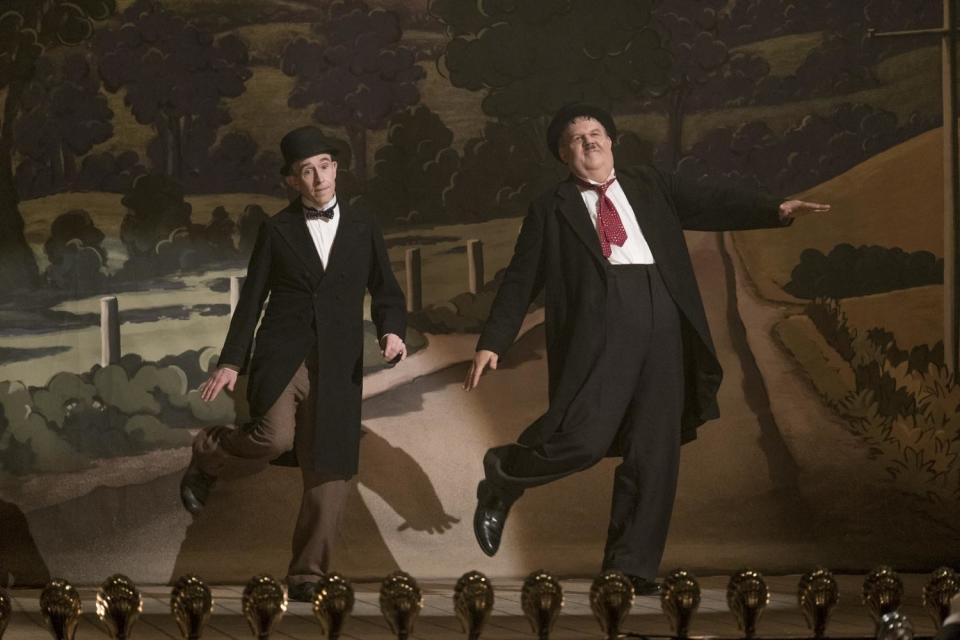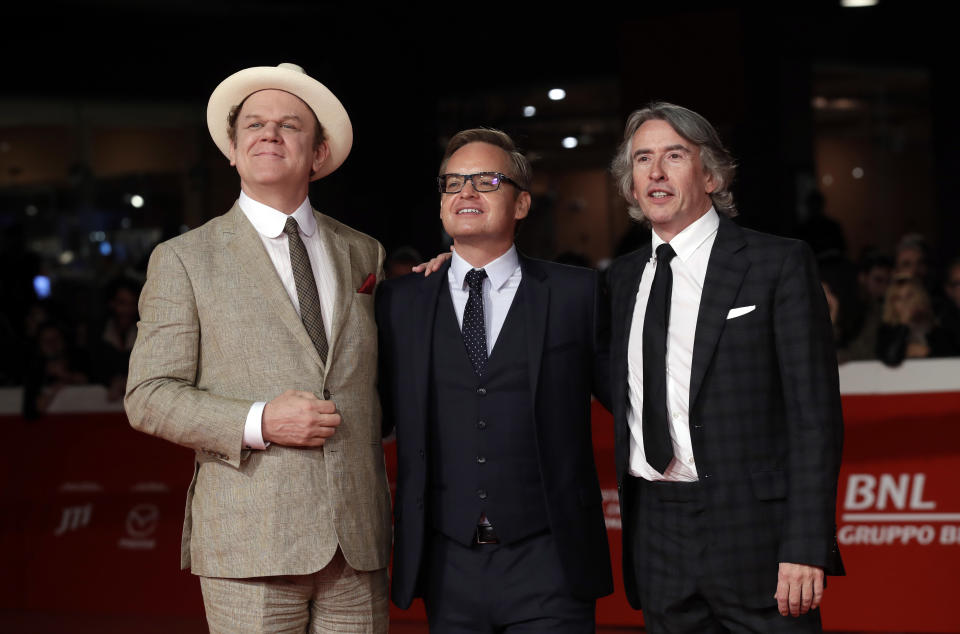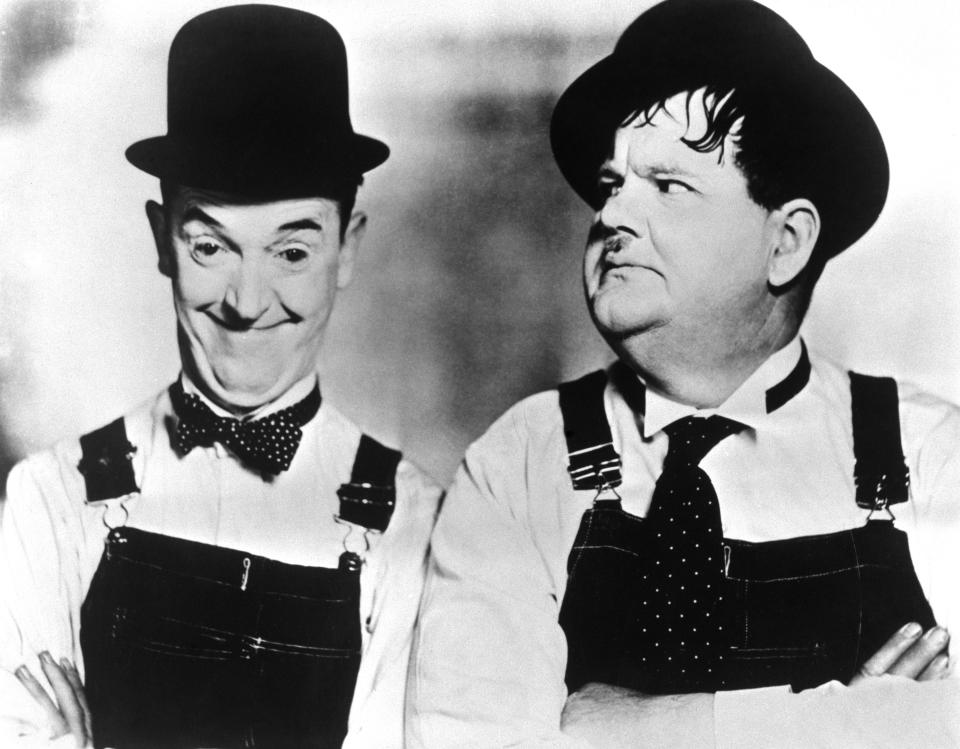'Stan & Ollie' director Jon S. Baird says Martin Scorsese acted as a 'mentor' on Laurel & Hardy biopic (exclusive)

It might seem hard to believe, but Stan & Ollie is only director Jon S. Baird’s third feature film, with football thug biopic Cass and foul-mouthed Filth his previous directing credits, before his stunning Laurel and Hardy biopic hits cinemas tomorrow.
Starring Steve Coogan and John C. Reilly as silver screen icons Stan Laurel and Oliver Hardy, it tells the story of the comedy duo in their twilight years as they embark on a U.K. tour.
Baird has been mingling with Hollywood royalty for a while, thanks to a friendship with Martin Scorsese forged on the set of Scorsese’s music industry TV series Vinyl, which Baird guest-directed.
“[Scorsese’s] actually become a bit of a mentor,” Baird tells Yahoo Movies UK. “On this film he advised me quite a lot on things like lens choice, and how to construct one long take. When I go to New York I sit with him and drink tea. So it’s been great, it’s been a really great relationship to build with the master.”
And one of the perks of having access to Scorsese’s living room is that you get personal feedback from cinema’s greatest living director, as Baird tells Yahoo Movies UK when we ask him about one of the film’s key moments.
“When they’re dancing on stage,” Baird revealed, “we choose to follow their shadows at points. First of all, we’re showing how iconic those shapes are. Because you could look at a poster of their silhouettes and tell it’s Laurel and Hardy, so we were doing that.
“But on a more dramatic and emotional level, we’re signifying that they’re on their way out, this is the last time we’ll see them, their shadows are disappearing.”
“Talking about Scorsese, that’s his favourite shot of the whole film. It’s the thing, when I first showed him the film, he picked up on and said ‘I love that shot at the end there.’”
But forget Scorsese, this moment is about Baird, and his BAFTA-nominated exploration of Stan Laurel and Oliver Hardy’s final days together – a film that’s exactly as funny, powerful and moving as that description makes it sound.
We sat down with the director to find out what it’s like to work with Steve Coogan, how he stopped Stan & Ollie from looking like an ITV drama, and why it’s important to change your shoes every day on set.
Yahoo Movies UK: Last night at the screening, Steve’s last words before the film started was ‘You might think it’s s***!’ which was a joke that I thought was really revealing about the sensitivity of comedians, and actors in general, which really ties to Stan & Ollie. How do you navigate the sensitivity of the artist when you’re directing?
Jon S Baird: Every actor is different, so you’ve got to be like a school teacher, or a parent in a way – you’ve also got to be like a football manager. You’ve got to have discipline, but you’ve got to have them trust you – that’s the first thing with an actor. Sometimes they’ll push you and push you to see how far they can go, it’s no different to what a kid would do to a new teacher at school.
Sometimes it’s like you’ve got a new puppy in your house and they’re running around, it can be like that as well. You’ve got to be able to give guidance while retaining respect and trust as well.
But all actors are different, some will need more attention than others, some will try it on… But really it’s like being a teacher.

That makes so much sense, in teaching terms it’s always better if they find the answers themselves, it’s about the journey to the solution…
Yeah, the worst thing you can do to an actor is say ‘Read it like this!’ Especially with the older actors, you see the look of horror on their face if you suggest something like that.
John [C Reilly’s] interesting, because he’s worked with [Martin] Scorsese before [on The Aviator] and I’ve since worked with Scorsese a few times, but John says that when Scorsese’s directing him, he talks around the subject and you have to work out what he’s saying because he doesn’t want to disrespect you, and apparently it’s quite an Italian thing to do.
With an audience for a film, it’s better for them to work things out as they’re going along rather than being spoon-fed and it’s the same for an actor. They’ll be more satisfied.
You mention working with Martin Scorsese, I know you worked with him on Vinyl, but I didn’t know you’d worked with him again?
He’s actually become a bit of a mentor, on this film he advised me quite a lot on things like lens choice, and how to construct one long take. When I go to New York I sit with him and drink tea. So it’s been great, it’s been a really great relationship to build with the master.
There’s a beautiful opening shot, which has Stan and Ollie in front of mirrors, that are angled so they’re together in each mirror. Later in the movie, we see a similar set-up, but they’re separated, before a key argument. Can you talk a little about how you told the story visually? Are there any other visual metaphors that I might have missed?
One of the big visual metaphors is at the very end, when they’re dancing on stage, and we choose to follow their shadows at points. First of all, we’re showing how iconic those shapes are. Because you could look at a poster of their silhouettes and tell it’s Laurel and Hardy, so we were doing that.
But on a more dramatic and emotional level, we’re signifying that they’re on their way out, this is the last time we’ll see them, their shadows are disappearing.
Talking about Scorsese, that’s his favourite shot of the whole film. It’s the thing, when I first showed him the film, he picked up on and said ‘I love that shot at the end there.’
It was one of the first days of the shoot, funnily enough. Things like that often happen, where you think ‘Oh f****, the first week’s going to be so tricky, how are we going to do this?’ And you end up doing some of your best work early on, because you’re so pumped up.
How do you keep going on a shoot as intense and complex as this? Because obviously enthusiasm is a big part of what a director brings to the set.
It’s very simple things, like you take on a lot of water. Because the easiest thing on a film set is to tire yourself out. You’re using so much energy thinking, you’d never think that’s draining you as well, so you really have to hydrate yourself and try and get as much sleep as you can.
I tell you what I do, and this was told to me by Walter Hill, I went for dinner with him a few years ago and I asked him ‘Walter, what advice would you give to an up and coming director?’ And he said ‘Well, I’ll tell you what Raoul Walsh told me…’ It was passed on. And he said ‘Never sleep with a leading lady unless you’re going to do it all the way through the shoot.’ Which I totally get.
[Laughs]
‘Always change your shoes at lunchtime, because it feels as though you’re going into a new day.’
That’s brilliant.
It’s completely true and I do it every time. I always wear shoes then trainers, or trainers then shoes. And ‘Always let the actors choose their own hats.’ In a broader sense, give them a bit of ownership over their costume, because they’ll really repay you if you do that. I’ve tried to stick to those things.

What I do at lunchtime is I always get a sleep, whatever I’m doing. I hate working straight days without lunch, because I need half an hour at lunchtime just to switch off and sleep, because I find in the afternoon I’m done if I don’t get some sleep.
What shots or sequences excited you most when you played them back, or are you the kind of director who watches on the monitor?
I’ll watch things on the monitor, unless it’s completely impossible to get a feed. That opening tracking shot was difficult because we were travelling over such a long distance, it was difficult to get a feed from the camera back to the monitor. So what we did – and this is quite a funny thing – we had one of the camera department dress up as one of the extras on set, in the studio, so if you look carefully enough, you’ll see him.
You’ll glimpse him as he’s walking past, he’s actually carrying the transmitter from the camera that’s shooting back to where to monitors were. We digitally removed the cable that’s coming back to the box. A lot of challenges, but you always find a way.
Were you ever tempted to shoot the film in black and white?
I thought about it very briefly, but the movie’s called Stan & Ollie, if we called it Laurel & Hardy and shot it in black and white people will be expecting a comedy, and we wanted to avoid that.
Also, things like the Robin Hood film, because it was a fantasy scene, it was important for that to look technicolour, because that’s what it would have looked like back then, and slightly surreal and heightened, because it’s in their imagination.
There were a few things pushing us against it being black and white, and it limits you as well, in terms of the audience. It’s quite a bold move. I know The Artist did it and it worked really well for them, but I didn’t think it was the right choice. We did consider it.

Nina Arianda, who plays Stan’s wife, Ida Kitaeva Laurel, is a total scene stealer.
John always says ‘Watch your wallets when Nina’s around,’ because she is.
This might sound bad, but the movie’s called Stan & Ollie, so I honestly wasn’t expecting to be as invested in the wives.
Yeah, yeah.
But I could have watched a whole film with just those two.
Maybe we should do a spin-off with them.
Seriously, I’d love it. Can you talk about working with them?
I’d worked with Shirley before, she was in Filth and she’s become a good friend. Nina, I always wanted someone of Eastern European descent to play that part, to understand the Slavic nature of that character and the tough love that they have, and the humour that they have. And Nina’s parents are from the Ukraine, so that’s why she got involved.
She’s one of the best actors I’ve ever worked with, if not the best. How she elevates what’s on the page, to what’s on screen, I’ve never seen it done [like that] before. She takes the smallest idea, and expands it.
There was a line in the script from her character, Ida, she says: ‘I don’t like this Delfont.’ and from that, Nina built in all this… it was her idea to say: ‘I’m not sitting next to him,’ she did all that herself.
That’s an amazing thread.
None of that was in the script. That’s all her.
And, of course, John C Reilly and Steve Coogan, how did you collaborate with them, and was it a concern that the performances didn’t slip into impersonations?
It was a concern before we got them in rehearsals, but as soon as we got them, I realised that wasn’t going to happen. We did a lot of rehearsal, we did four weeks of rehearsal and that’s really unusual for a movie of this size.

Steve is a very good mimic, so it could have been more his character that went into that, but you could tell on day one he was there. He impressed me most in terms of what I expected and what I got. I’m so delighted he got the BAFTA nomination because he completely deserved it.
John was nominated for a Golden Globe, Steve has just been nominated for a BAFTA, how does it feel to see this double-act being honoured separately? Was it weird when John was nominated on his own, for example?
It’s balanced itself out, but it was disappointing. It’s almost like a poisoned chalice, they split the vote. Some people say they prefer this one, some people prefer this one – maybe John still got a huge amount of votes, and maybe Steve got a huge amount of votes, but they cancel each other out. Who knows? It would have been nice if they were both up there.
There was one stage where the distributor was thinking about putting one up for lead and one for support, but people would see through that, it would be seen as a cynical move. But I’m glad Steve’s got this one.
You’ve said that the script had darker elements that were removed, can you talk a little bit about those elements?
One version of the script concentrated a lot on Stan’s drinking and the fights he was having with ex wives, it was really dark. There was one scene where he dug himself a grave in his garden and lay down in this hole looking up at the stars, that was really dark – that would have been a completely different film.

There was profanity, but we just took all of that out, because we wanted to make this kind of film. It was a gamble, because there’s the danger that people will think it’s too sentimental, or too soft – but we said that’s the film we want to make, it’s a love story, it’s not an expose.
It’s balanced, there are dark elements.
Absolutely, but not as dark as it could have been.
When I was younger, Laurel & Hardy were on TV a lot, was it the same for you?
Exactly the same, yeah.
What’s your most vivid memory from that time?
My most vivid memory? I’ll show you, it’s a picture of me dressed as Stan Laurel at the school fancy-dress party, I’ll put it up and show you. That reminds me of what it was like that back then.
What is it about the characters that resonate so much with children?
What Laurel & Hardy are is these two kids in adult bodies, they’re doing what kids do. It’s a simple as that – that’s the secret of their success, really.
You shot at Pinewood at the same time as Star Wars, how did it impact on Stan & Ollie?
It totally impacted on us. It actually influenced me in one thing, for the opening shot of the film where we’re snaking around the backlot, we wanted it to look very normal. So the extras were doing things that were very normal for the day.
There’s two Roman guys playing baseball, there’s an Egyptian guy having a cup of coffee and smoking, these are all extras from different things, and I got the idea for that from walking through Pinewood and seeing a Stormtrooper on his iPhone. So I thought ‘What would be the equivalent to that in the 1930s?’ So Star Wars did have an impact in a strange way.
Read more
BAFTA 2019 nominations: The biggest snubs and surprises
BAFTAs 2019: Full list of nominations
John C. Reilly spent hours in make-up to transform into Oliver Hardy

 Yahoo Movies
Yahoo Movies 

